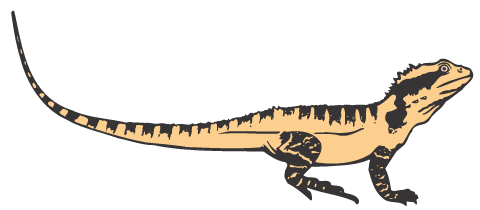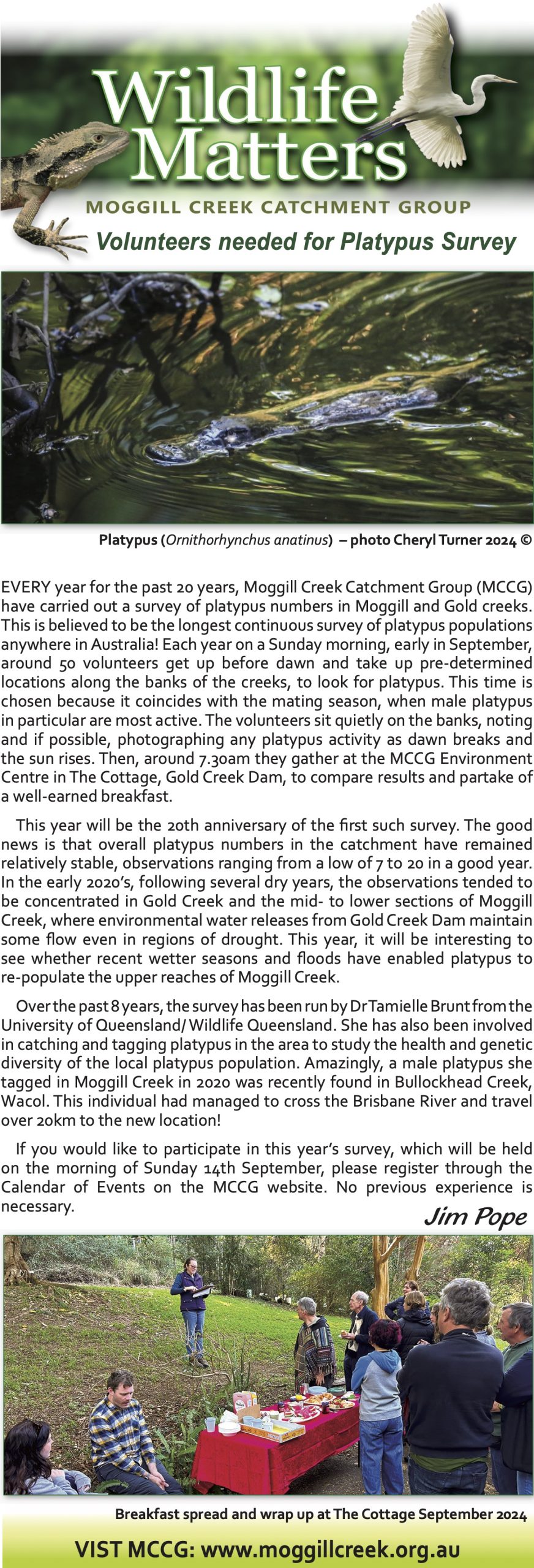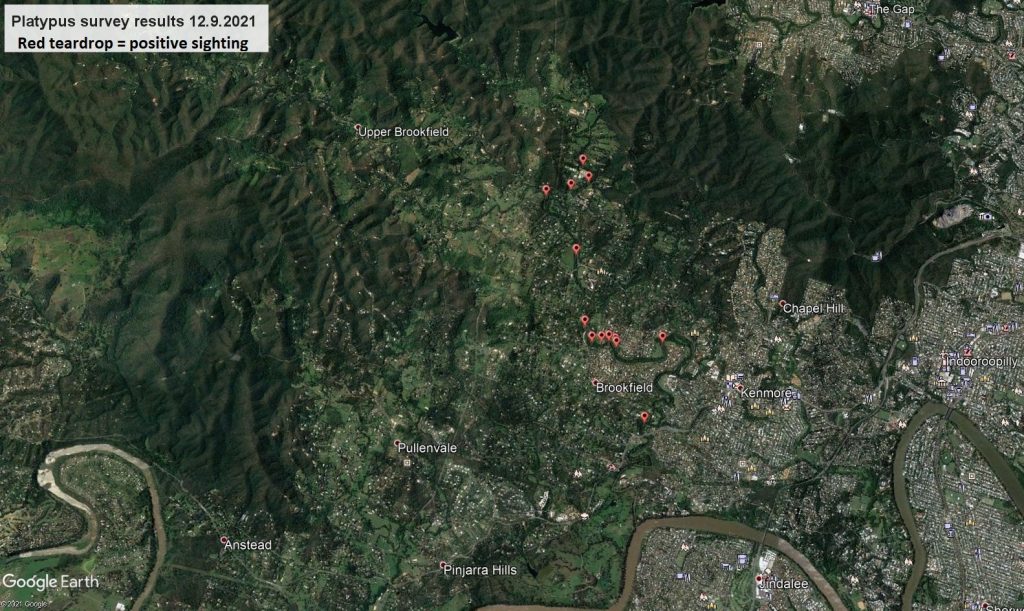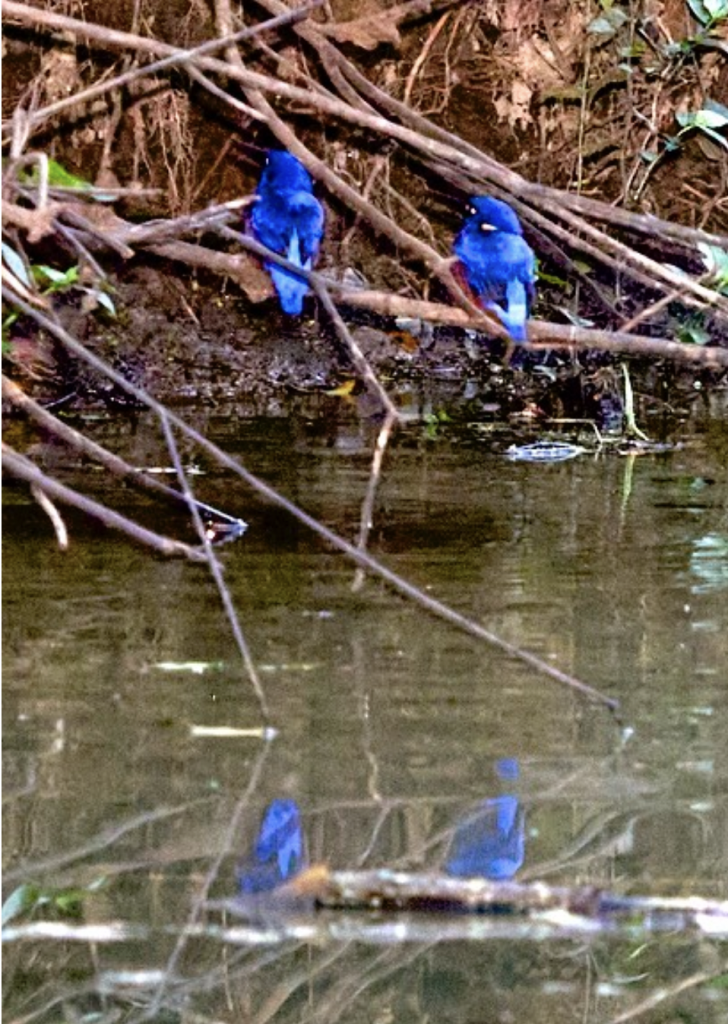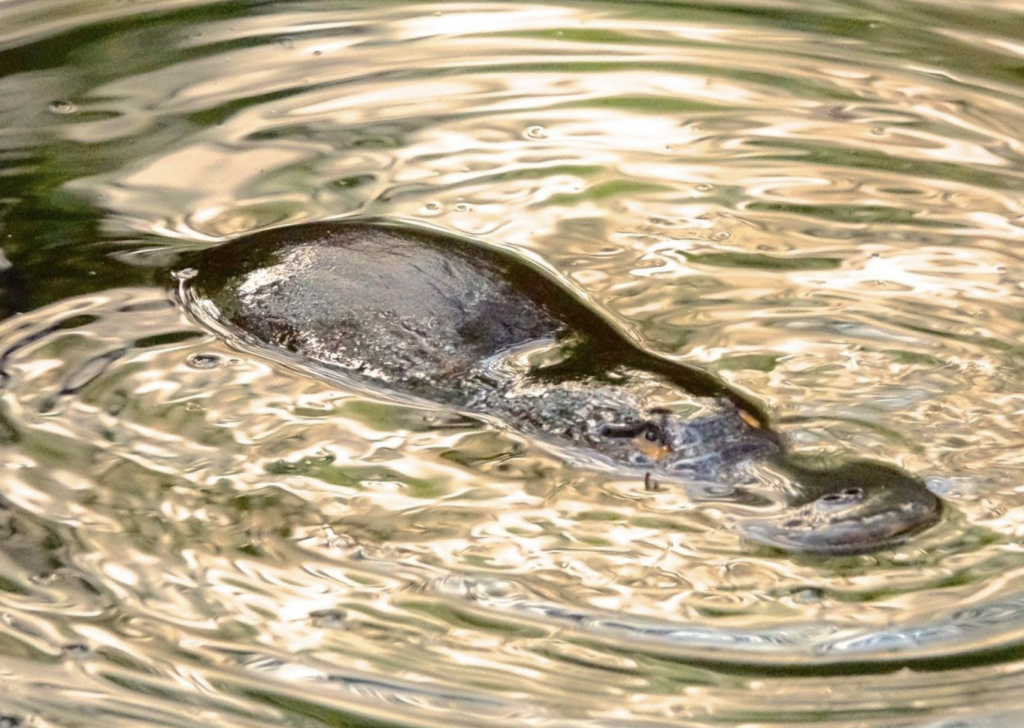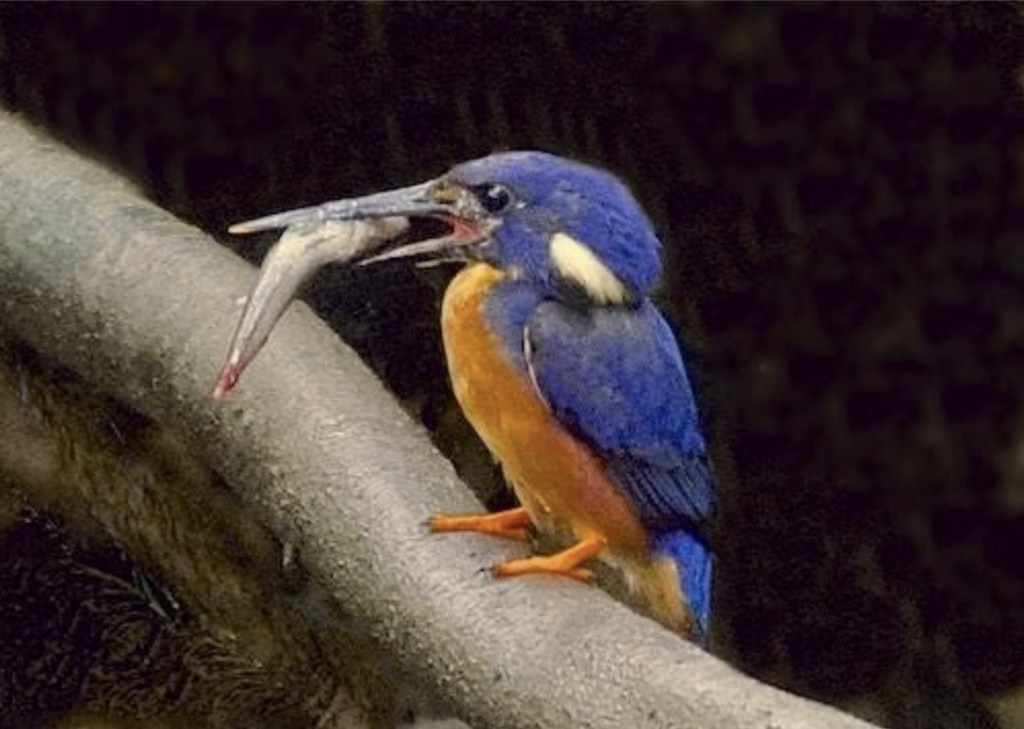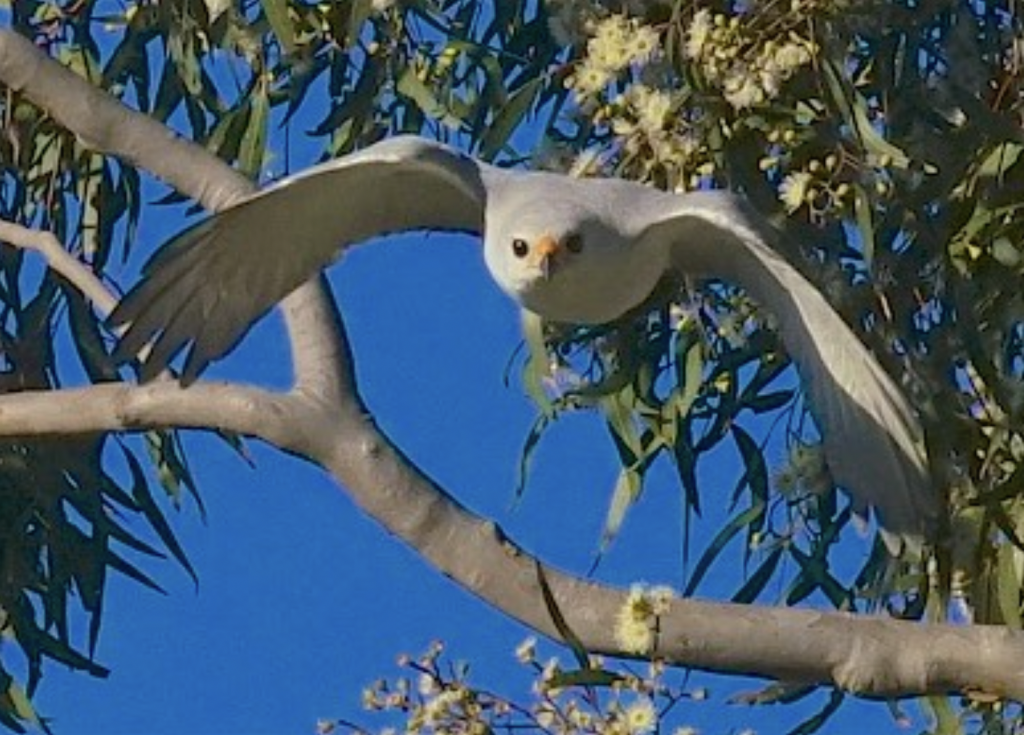Wildlife Matters is published in: 
Platypus
Moggill Creek Catchment Group Annual Platypus Survey Results 2023
This year’s annual platypus survey saw 47 volunteers cover 34 sites across Moggill, Gold and Farm Creeks.
There were 9 individual platypuses sighted across Moggill and Gold Creeks. An exciting sighting was recorded at the foot bridge in the Gold Creek Reservoir. After the 2022 floods,we didn’t have sightings of the resident platypus and it was thought it may have been washed downstream. It was great to confirm presence in the pool again.
Platypuses had been in the last few weeks in the usual hotspot area of Huntington Estate, but they eluded us in that area on the survey morning.
Platypuses rely on water for their essential activities, including feeding, mating, and navigating through creeks. Pools play a crucial role in their habitat because they can effectively search for food in water depths ranging from 1 to 5 meters. Currently, the creeks are fragmented due to the dry winter weather, potentially leaving platypuses isolated in the deeper pool areas. While platypuses are capable of traveling overland to seek water, this increases their vulnerability to predators like foxes, cats, and dogs, as they lack the speed to outrun these threats. As a result, these pools are expected to serve as vital refugia for platypuses during the upcoming years of drought.
Citizen Science is an important tool to help monitor wildlife populations. Thank you to all the volunteers who joined bright and early to help gain valuable data on the population. Thank you to the Team Leaders that helped navigate the volunteers to sites and to the Kenmore District Girl Guides Queensland for organising the post survey breakfast.
Footage from of a platypus in lower Gold Creek can be see here. https://www.youtube.com/watch?v=RPED7ketkus
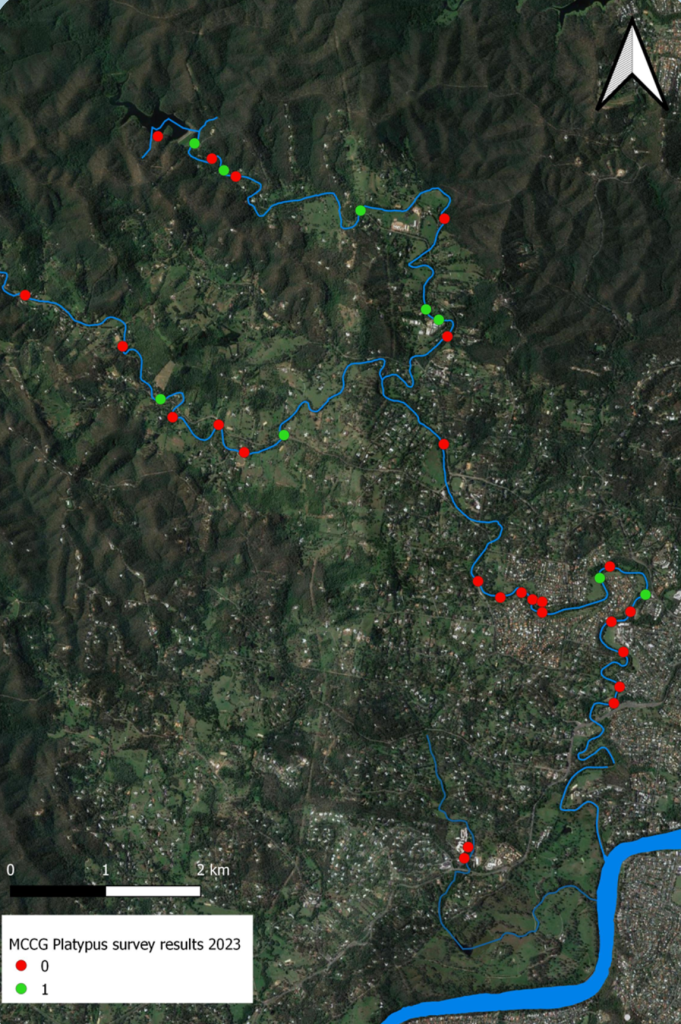
Tamielle Brunt
B. App. Sc. (Wildlife Science), PhD.
MCCG 2023 Annual Platypus Survey
The Moggill Creek Catchment Group invites you to join the annual platypus survey to help monitor the local population.
Date and time
Sunday, September 10 · 4:30 – 10am AEST
Location
Brookfield General Store 550 Brookfield Road Brookfield, QLD 4069
AGENDA
4:30 am
Meet at the Brookfield General Store to be allocated to your site Team Leader
5:00 am – 5:30 am
Be allocated to your site by Team Leader
5:30 am
Be set up at your site ready to observe
5:30 am – 7:30 am
Start survey
7:30 am – 9:00 am
End survey and travel to Breakfast at The Cottage, Gold Creek Reservoir
8:30 am – 9:00 am
Summary of sightings
Sign up for your free ticket through Eventbrite
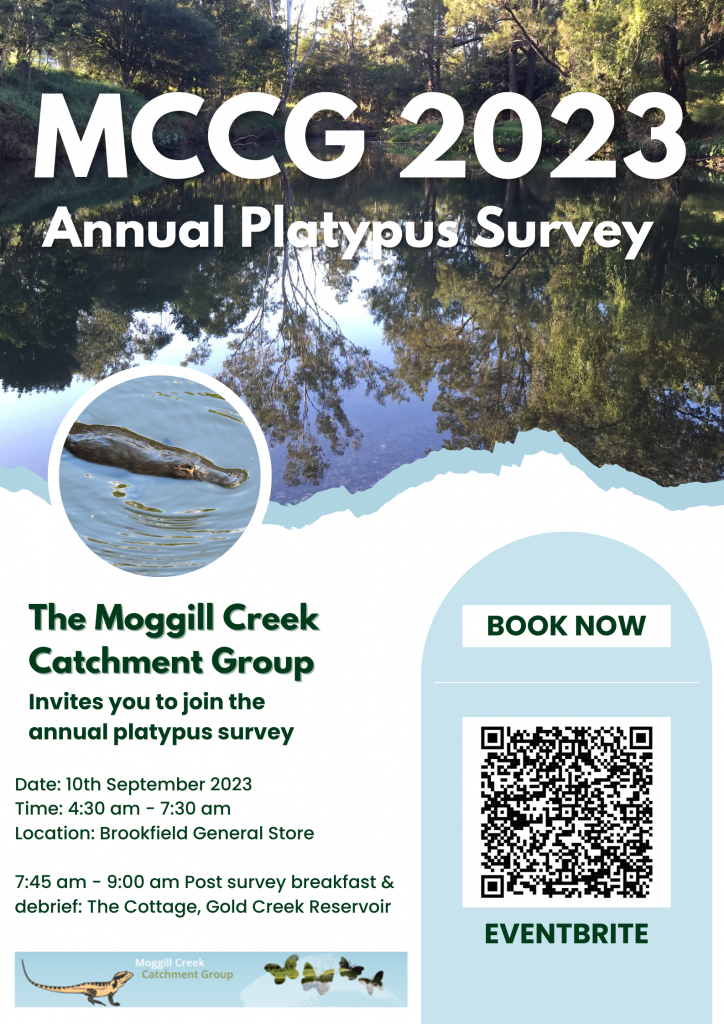
Results from the Platypus Survey 2021
There were at least 12 sightings this year which is great news and indicates that platypus are persisting in the Moggill Creek Catchment.
(Check out the map showing sightings and video below)
Key findings:
- Some observers saw two platypus
- When examining the times recorded, some may have been the same animals seen again by other observers downstream or upstream
- Three sightings in lower Gold Creek. In addition, on the evening before the survey, two platypus were video recorded at the confluence of Gold and Moggill creeks on a private property. The two were seen vigorously interacting
- One sighting in Moggill Creek near the Showgrounds
- Six sightings in mid-Moggill Creek, off Rafting Ground Road (Huntington Estate)
- One sighting a little further downstream in Kenmore Hills
- One sighting in a large pool in lower Moggill Creek, near Moggill Road
Unfortunately, many of our core historical platypus hotspots were again negative this year and this has been the pattern for some years. These include upper Moggill Creek (Upper Brookfield), mid-Moggill Creek (Kenmore High School region), lower Moggill Creek (Kilkivan/Fortrose Street area) and mid-upper Gold Creek. This is always a concern, with water extraction from the creeks and general watercourse degradation from human activities continuing to occur in what is a peri-urban environment. Interestingly, the sightings this year were, however, mostly in the more urbanised creek areas.
Thank you again to Dr Christine Hosking for running the annual Platypus Survey in Moggill Creek Catchment and to all the volunteers who are up early for Platypus watching.
Wildlife Matters!
MCCG Annual Platypus Survey
Moggill Creek Catchment Group have been carrying out annual platypus surveys in the catchment since 2005. The surveys are coordinated by Dr Christine Hosking (UQ) and held in early September each year during the breeding season, when platypus are most active. Since platypus are predominantly nocturnal, the surveys involve 50 or so volunteers taking up predetermined observation sites before dawn, observing their section of the creek for a couple of hours, then sending in their report (with photos where possible) for collation and analysis of the results. Observers need to be careful not to mistake other species, notably water dragons, freshwater turtles and the rarer native water rats (Rakali) which are distinguishable by the white tip on their tails.
Regular surveys of native wildlife are important in monitoring the health of the environment over time, with changes in numbers providing important indicators of seasonal variations due to drought, flood, bushfires etc. and longer-term changes due to pollution, land clearing, urban development and climate change. Platypus numbers are a good indicator of creek health, but are significantly affected by drought and flood cycles. Since 2005 the surveys have recorded individual platypus sightings across the catchment varying from around 6 to a maximum of 20. Numbers were low following the drought years of 2005-7 but recovered in 2008. They fell in 2013 and again in 2018 following dry winters, but overall seem to be reasonably stable, averaging around 11 confirmed sightings each year. Recently there have been few sightings in the upper reaches of Moggill Creek, with numbers concentrated in Gold Creek and the mid-sections of Moggill Creek, both of which benefit from environmental flows emanating from Gold Creek Dam.
In previous years participants were rewarded by a cooked breakfast at the Pony Club in the showgrounds, but this has not been possible over the last two years due to Covid restrictions. This year’s survey was held on Sunday 12thSeptember. Results are still being verified but about 11 confirmed sightings were recorded. Many thanks to all those dedicated volunteers who sacrificed a Sunday sleep-in for a very good cause!
Jim Pope
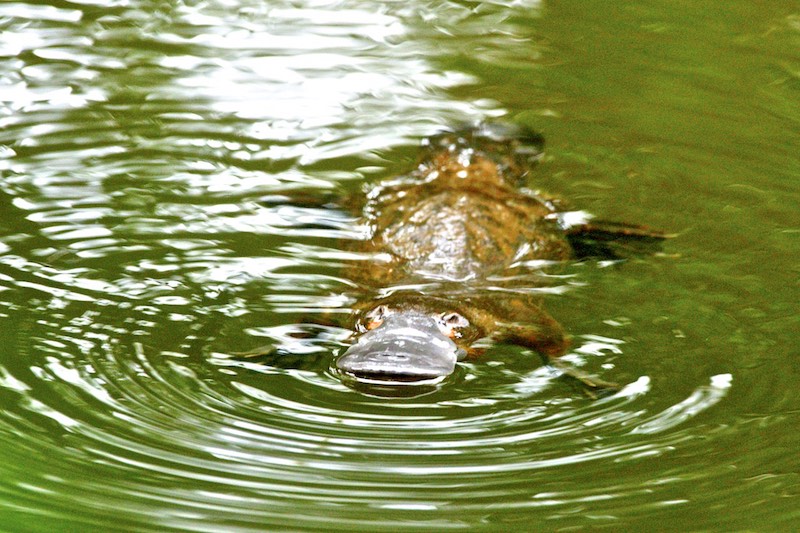 Platypus Moggill Creek Photo: Ed Frazer
Platypus Moggill Creek Photo: Ed Frazer
Published in

Platypus Update
There has been a lot of activity with the Platypus in the past week.
The female near my hide has been emerging from her den most mornings and again late in the afternoon. She comes out for two or three dives and then retreats. She doesn’t travel far and before she comes out there is a lot of stirring of the water as she is probably rearranging the plug of earth she has at the entrance of her den. I think she is mainly just getting wet to keep the moisture in the nest as the eggs and young Puggles need to be kept moist. She probably feeds a little on her outings, but at this stage she is probably relying on the reserves in her tail to supply the rich milk she exudes from her belly for the Puggles to grow.
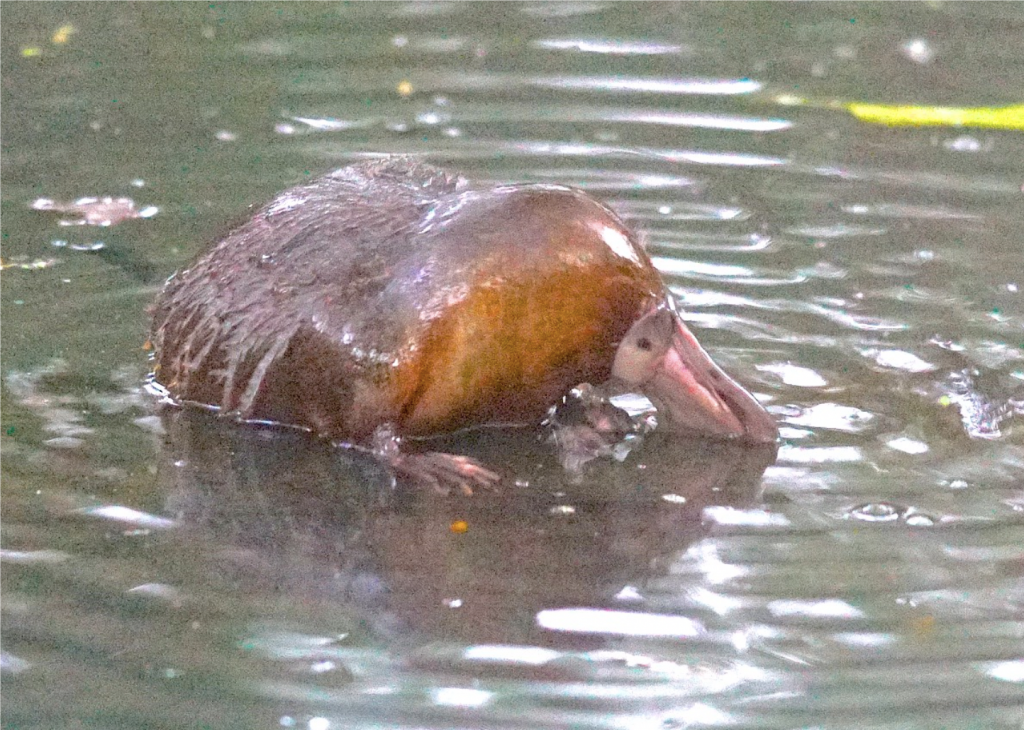
Platypus having a scratch. Platypus vary in colour but most have lighter colour underneath. Photo: Ed Frazer
The real activity has been from two males. I noticed the female going towards the den and there was quite a commotion not far away. Two Platypus were fighting near the edge of the creek and water was splashing everywhere. It went on for only a few minutes and then one swam along the surface at high speed up the creek. A few seconds later the other followed. It was very unusual to see three Platypus at the same time as they are usually very solitary animals. While I am pretty sure the female now has hatched her eggs, it appears the males are still searching out mates. Unlike the females the males swim very quickly in large hops of about 30 metres, mostly on the surface with a long bow wave. The females make several dives about 45 seconds apart with a stream of bubbles showing where they are feeding. The dives travel only a few metres and they are easy to trace with their bubble stream.
All up I think we have 5 Platypus in the two large pools along our property and it will be interesting to see how many are sighted in the MCCG Platypus Survey in September. The males cover a kilometre or two of the creek and use several dens in different places so there is no guarantee they will be around our area in the survey.
Two Azure Kingfishers have been taking turns at digging out a nesting hole directly opposite my main hide. They do check out several possibilities, but this pair look serious about this hole behind a group of roots sticking out of the bank.
For more information on previous annual Platypus Surveys click here
Text and photos by Ed Frazer.
Platypus on the move
It looks like a bumper year in Platypus activity in Gold and Moggill Creeks this year.
After several years of poor rainfall and little flushing out of the creeks, more consistent water flow has restored the aquatic habitat and the animals appear to be responding.
Platypus Photo: Ed Frazer
Ed Frazer has been monitoring part of Gold Creek that includes two large stretches about 400 metres long and 8 metres wide that were the local swimming holes in past years.
There have consistently been three breeding females in these ponds that have regularly been monitored in the annual Platypus Survey carried out each September. He suspects that they didn’t breed last year because of the poor condition of the creek.
“There has been a lot of activity up to mid-July with mating season starting” Ed said. “I regularly see the females feeding as late as 8am as they build up their condition for the egg laying and raising their two young. The good water conditions have resulted in a plenty of food, especially the Dragonfly larvae which I think is a major part of their food in our area.”
The females tend to move around the snags in the creek where there has been a considerable build-up of rotting down leaf matter where the insects feed. Luckily we haven’t had a strong flood in the creek that cleaned out this habitat as often has happened after a period of drought in the past. The females sighted had thick tails a sign of good condition for raising their young.
“The male Platypus behaviour is quite different at this time of year. I see them travelling through at impressive speed, sometimes on the surface, but often in shallow dives coming up for air every 45 seconds at a distance of about 30 metres. They are looking for mates at this time of year”.
By July 17 sightings suddenly ceased and Ed thinks that early egg laying had started and the females were in their dens incubating the eggs that take about 10 days to hatch.
In August the activity will slow down while the young are small and the females are using their reserves built up in the tails to supply food for the small puggles.
By September the young will be more demanding and the females will be out more in the early morning and before dusk to keep up their food. This is when the MCCG Platypus survey is held while the activity is at its height.
There is plenty of other activity in the creek to watch while waiting for the Platypus to put in an appearance. There are a number of Striated Pardalotes building their tunnels in the banks of the creek this year as the soil is nicely moist from the recent rains. They are lining their nesting chambers with feathers and trying to out-compete their neighbours with their distinctive three note call.
Azure Kingfisher Photo: Ed Frazer
The beautiful Azure Kingfishers are flying rapidly along the length of the pools stopping to perch on overhanging branches ready to strike on any fish near the surface. Their activity seems to be co-ordinated with the Platypus as they appear to be taking advantage of the fish disturbed by the strenuous stirring up of the fish on the bottom of the creek. They too will start building their nesting chambers in the banks of the creek and they should have a good chance of raising 4 young with the ideal conditions this year. There is also a beautiful Grey Goshawk that patrols along about 2km of the creek looking for prey just under the overhanging trees.
Grey Goshawk Photo: Ed Frazer
There are a lot of good photo opportunities around the local creeks and MCCG holds its annual Photography Competition in October each year, so a good turnout should be expected after two lean years of near drought.
Words and all photos by Ed Frazer

